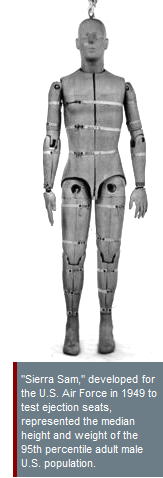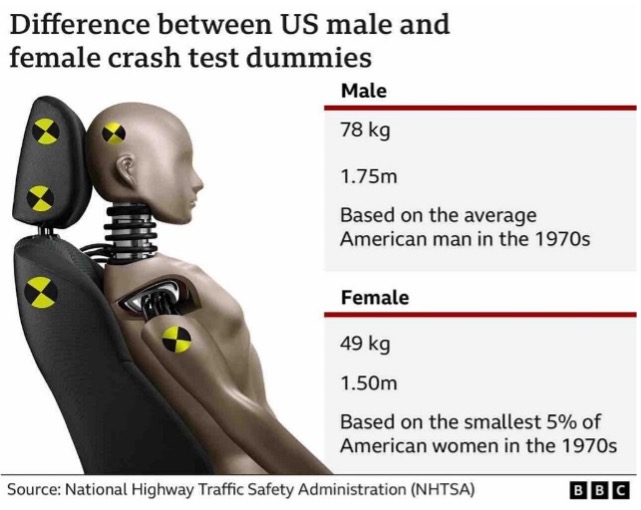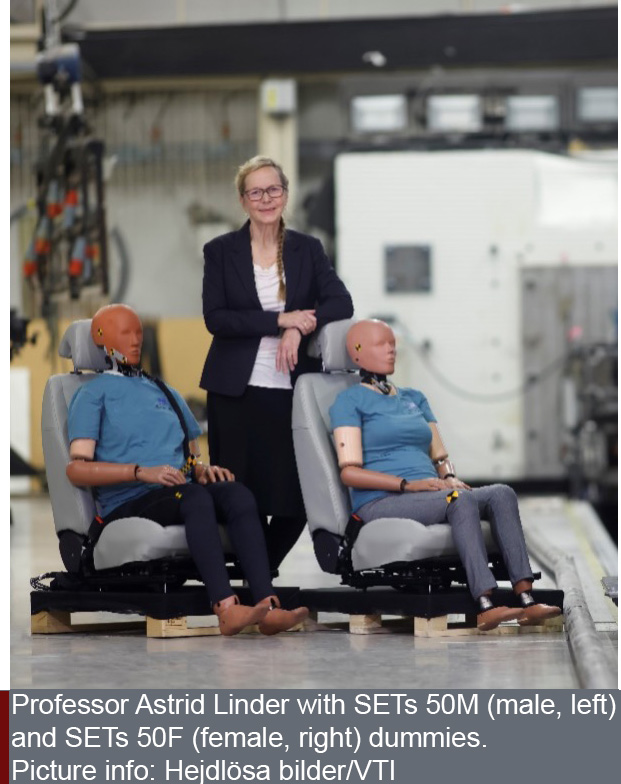Sex & Gender Analysis
Case Studies
- Science
- Health & Medicine
- Chronic Pain
- Colorectal Cancer
- Covid-19
- De-Gendering the Knee
- Dietary Assessment Method
- Gendered-Related Variables
- Heart Disease in Diverse Populations
- Medical Technology
- Nanomedicine
- Nanotechnology-Based Screening for HPV
- Nutrigenomics
- Osteoporosis Research in Men
- Prescription Drugs
- Systems Biology
- Engineering
- Assistive Technologies for the Elderly
- Domestic Robots
- Extended Virtual Reality
- Facial Recognition
- Gendering Social Robots
- Haptic Technology
- HIV Microbicides
- Inclusive Crash Test Dummies
- Human Thorax Model
- Machine Learning
- Machine Translation
- Making Machines Talk
- Video Games
- Virtual Assistants and Chatbots
- Environment
Inclusive Crash Test Dummies: Rethinking Standards and Reference Models
The Challenge
Crash test dummies are used in auto safety testing. These dummies vary by height and weight to represent human populations. The 50th percentile male dummy (a dummy modeling the average male body) is most commonly used. A 5th percentile female crash test dummy (representing the smallest 5th percent of the female adult population) was introduced in 1966, but this dummy is simply a scaled version of the 50th percentile male body and does not model female bodies. Still lacking is a 50th percentile female dummy that models female-typical injury tolerance, biomechanics, spinal alignment, neck strength, muscle and ligament strength, dynamic responses to trauma, and other female-typical characteristics. Consequently, women sustain more severe injuries than men in comparable crashes.
Method: Rethinking Standards and Reference Models
The male body is often defined as the norm and serves as the primary object of study. In this case, crash test dummies were first developed in the U.S. to model the 50th percentile man. This means that the female part of the population was left out of the research discovery phase. Inattention to humans of different sex, size, shape, and age may result in unintended harm.
Gendered Innovations:
1. Expanding established norms to represent a greater variety of bodies may enhance automotive safety. From the start, automobiles and safety devices should be designed for broad populations, including diversity in age, body weight and height, injury tolerance, and mechanical response to impact for both sexes.
2. A pregnant computer model makes possible investigating crash impacts on fetuses.
Gendered Innovation 1: Expanding Established Norms
Method: Rethinking Research Priorities and Outcomes
Method: Rethinking Standards and Reference Models
Method: Analyzing Sex
Gendered Innovation 2: Pregnant Computer Crash Simulations
Conclusions
Next Steps
The Challenge
 In engineering design, the medium-sized male body (1.75 m; 78 kg) has been taken as the norm. It is no surprise then than men fitting this profile suffer the fewest injuries in automobile accidents (Carter et al., 2014).
In engineering design, the medium-sized male body (1.75 m; 78 kg) has been taken as the norm. It is no surprise then than men fitting this profile suffer the fewest injuries in automobile accidents (Carter et al., 2014).
When crash data is analyzed by sex, age, height, and weight, injury rates are higher among people who don’t fit the mid-sized male norm. Elderly drivers have high fatality rates per vehicle mile driven (Augenstein et al., 2003). Obese drivers also risk death and serious injury. And women are more likely than men to be injured in crashes. When considering the compounding interaction of these factors, elderly females and obese males suffer greater injury in crashes of equal severity than the “standard” male (Carter et al., 2014).
Gendered Innovation 1: Expanding Established Norms
Numerous efforts are underway to expand computational models to represent greater diversity of human bodies, such as properly modeled females (Östh et al., 2016), elderly and overweight females and males, (Hu et al., 2012), and children (Carter et al., 2014). Still lacking are physical crash dummies to model these populations, with the exception of children (see Method: Rethinking Standards and Reference Models).
 Females: Women are involved in fewer severe automobile crashes overall, but when they are involved in a crash, they are more likely to sustain serious injuries, even when using seat belts. National U.S. automotive crash data from 1998 to 2008 revealed that the odds for a belt-restrained female driver to sustain severe injuries were 47% higher than those for a belt-restrained male driver involved in a comparable crash, when controlling for weight and body mass (Bose et al., 2011).
Females: Women are involved in fewer severe automobile crashes overall, but when they are involved in a crash, they are more likely to sustain serious injuries, even when using seat belts. National U.S. automotive crash data from 1998 to 2008 revealed that the odds for a belt-restrained female driver to sustain severe injuries were 47% higher than those for a belt-restrained male driver involved in a comparable crash, when controlling for weight and body mass (Bose et al., 2011).
Crash test dummies designed to represent the 5th percentile “female” by height and weight (1.50 m, 49 kg) were developed beginning in 1966, but these are only scaled-down versions of the standard, mid-sized male and not modeled on the female population. Thus, the 5th percentile dummy does not represent the average: 1) female geometry, such as the shape and form of the torso; 2) female muscle and ligament strength; 3) female spinal alignment; 4) female dynamic responses to trauma; 5) mass distribution of different body parts (Linder & Svedberg, 2019; Linder et al., 2013a; Linder et al., 2013b; Hu, et al. 2012) (see Method: Analyzing Sex).
 Researchers have developed a numerical model of a 50th percentile female—the EvaRID (Rear Impact Dummy)—and a physical prototype of a 50th percentile female dummy—the BioRID 50F. But these models have not yet used in national automotive testing either in Europe or in the U.S. (Linder & Svensson, 2019). For certain tests, a 5th percentile dummy is included only in the passenger seat (apparently assuming that women don’t drive; Linder & Svedberg, 2019). When this 5th percent female dummy is moved to the driver’s seat, the risk of death for females decreases dramatically (Noh et al., 2022).
Researchers have developed a numerical model of a 50th percentile female—the EvaRID (Rear Impact Dummy)—and a physical prototype of a 50th percentile female dummy—the BioRID 50F. But these models have not yet used in national automotive testing either in Europe or in the U.S. (Linder & Svensson, 2019). For certain tests, a 5th percentile dummy is included only in the passenger seat (apparently assuming that women don’t drive; Linder & Svedberg, 2019). When this 5th percent female dummy is moved to the driver’s seat, the risk of death for females decreases dramatically (Noh et al., 2022).
Professor Astrid Linder, Research Director of Traffic Safety at the Swedish National Road and Transport Research Institute, has been instrumental in developing the SETs (Seat Evaluation Tools) that model both the geometries of an average male and average female to evaluate the safety of car seats in a low severity rear impact (Karemyr et al., 2022). The SETs could be integrated in the safety testing.
Obese People: The 50th percentile male dummy used in tests today represents the average height and weight of men in the late 1970s and early 1980s (Schneider et al., 1983). Today, the U.S. Centers for Disease Control classify almost 40 percent of Americans as obese (Centers for Disease Control, 2018). People with high Body Mass Index (BMI) are more likely to suffer severe lower extremity and thorax injuries in crashes than people with low BMI (Carter et al., 2014). Data from field tests, cadaver tests, and computational studies have shown that increased body mass causes obese individuals to move forward in a frontal crash, increasing the risk of injury to the thorax and the knee, thigh, and hip complex (Hu et al., 2012). Obese females are more likely to die in vehicle crashes than obese males (Rice & Zhu, 2014).
Elderly: Populations in many countries are aging. By 2030, over 25% of the populations in Europe and North American are expected to be over age 60 (United Nations, 2015). National U.S. data show that older people are more likely to experience serious injuries in almost every crash type (Carter et al., 2014). Older people have less dense bones and experience changes to the thorax region which increase injury risk. Older women are at the greatest risk of bone fracture (Hu et al., 2012).
Method: Rethinking Standards and Reference Models
Test dummies were first developed for the U.S. Air Force in 1949. Women were excluded from major combat roles in the armed forces at this time, so the young, male body was given priority in the design of military safety technologies. This bias, however, was not corrected when test dummies were developed for civilian use, where both women and men of different ages, body habitus, and size have urgent safety needs. Researchers are now developing crash test dummies and computer simulations that represent average-sized women, elderly people, and obese people, though these are not yet required by law for automotive safety testing (Hu et al., 2012; Gruley, 2018; Linder & Svensson, 2019).
Method: Analyzing Sex
While developing anthropomorphic dummies, researchers noted that women's normal seated position differed from what was defined as the standard seating position. Women on average sit closer to the steering wheel to compensate for shorter stature, which puts them at greater risk for internal injury in frontal collisions (Augenstein, 2005). The notion that persons of small stature are out-of-position drivers implies that the problem is the smaller-than-the-norm driver, not the technologies (i.e., car seats and settings) that have not been designed to take the safety of all drivers into consideration. Analyzing sex may improve product usability and safety.
Gendered Innovation 2: Pregnant Computer Crash Simulations
The advances discussed above systematically exclude pregnant bodies. Conventional seatbelts do not fit pregnant women properly, and motor vehicle crashes are the leading cause of fetal death related to maternal trauma (Weiss et al., 2001; Acar et al., 2018). Even a relatively minor crash at 56km/h (35 mph) can cause harm. With over 13 million women pregnant across the European Union and United States each year, the use of seatbelts during pregnancy is a major safety concern (Eurostat, 2011; Finer & Kost, 2011).
Seatbelts were first installed in automobiles in the 1950s, and their use became mandatory in the late 1980s and early 1990s. As early as 1967, the American Medical Association advocated the use of seatbelts by pregnant women (Committee, 1972). At that time, little laboratory research in seatbelt design addressed pregnant women, making it difficult to assess the comparative effectiveness of various seatbelt designs and other safety technologies, such as the airbag (Insurance Institute for Highway Safety, 1972). As seatbelt usage increased, injuries caused by lap belts began to raise concerns that seatbelts might be hazardous to a fetus even when the mother is not injured (Committee, 1972).
Current research suggests that pregnant women should use the 3-point seatbelt (McGwin et al., 2004), yet for many women, particularly those who carry low, 3-point seatbelts ride up on the pregnant belly. In a crash, this increases force transmission to the abdomen by three- or four-fold relative to the force transmitted when the belt is worn below the uterus‚ with a corresponding increased risk of fetal injury (Pearlman et al., 1996).
The development of pregnant crash test dummies and computer simulations have the potential to play a key role in increasing seatbelt safety for fetuses.
A MAMA-2B (Maternal Anthropomorphic Measurement Apparatus, version 2B) was created in 1996 as a first step to modeling the pregnant body. In 2002, U.S. researchers adapted crash simulation software to model a 5th percentile dummy equipped with a virtual uterus, placenta, and amniotic fluid as well as uterosacral and round ligaments (Moorcroft, 2003). Using this computer model, validated by cadaver and real-world crash data, researchers modeled differences in outcomes between unbelted, belted, and improperly belted pregnant passengers. In 2008, researchers further improved this computer model by adding a realistic 38-week fetus (developed using ultrasound images) and modeling in utero fetal motion during impact (Acar et al., 2009).
In 2002, Volvo also developed a virtual pregnant crash dummy "Linda" in her 36th week of pregnancy. Other car companies and researchers have also used computer models and pregnant crash test dummies in safety testing (Hitosugi et al., 2018; Vladutiu & Weiss, 2012).
And research has begun to improve the 3-point seatbelt. One study recommends new materials—auxetic materials (image left)—for the lap belt to allow it to expand in order to lessen impact and to better keep the body in position (Panadero, 2020). Adding these auxetic properties to the current seatbelt design could enhance automobile safety for pregnant women and their fetuses.
Conclusions
Gendered Innovations have led to more inclusive standards for crash test dummies. In 2019, Volvo announced its E.V.A. (Equal Vehicles for All), an initiative that recognizes that virtual models and physical dummies need to represent a greater variety of body types. To this end, they are sharing their research and data from real-world crashes (Volvo, 2019). Academic and industry researchers are now ramping up efforts to expand crash test dummies to better model the human population. Women’s bodies, pregnant bodies, older bodies, and larger bodies, however, are still not standard or required in automobile safety tests.
Next Steps
1. The U.S. National Highway Traffic Safety Administration (NHTSA) currently requires safety testing using dummies modeling average and small male bodies, but not 95th percentile males, elderly people, obese people, pregnant women, or female bodies (the 5th percentile female is a scaled-down male dummy). The European New Car Assessment Programme (Euro NCAP) utilizes the same Hybrid III dummies as prescribed by the U.S. NHTSA, and as a result does not model a wide range of bodies in crash tests (Euro NCAP, 2010; Euro NCAP, 2009; Linder, A., & Svedberg W., 2019; Linder, A., & Svensson, M., 2019). Governments should mandate vehicle safety testing using crash test dummies or simulations that represent the anatomical features of both the 50th percentile female and male, pregnant, obese, tall, and elderly bodies.
In 2021, the Furthering Advanced and Inclusive Research for Crash Tests Act (FAIR Crash Tests Act) was introduced into a U.S. Congressional Committee. The Act ordered the Government Accountability Office (GAO) to evaluate NHTSA’s failure to use crash test dummies that represent the driving public, especially females, while assessing vehicle safety through its 5-star safety rating program. March 2023, the GAO delivered its report to Congress and the U.S. NHTSA (U.S. GAO, 2023).
2. The traditional 3-point seatbelt can harm a fetus. Redesigning seatbelts to accommodate pregnancy should become a priority for automobile makers. Private developers have introduced supplementary devices to hold conventional lap belts in place‚ but these have not undergone rigorous government safety testing (Klinich, 2009). A better solution may be a redesign of the conventional 3-point seatbelt to provide greater safety for all passengers.
Works Cited
Acar, S., & Lopik, D. (2009). Computational Pregnant Occupant Model, 'Expecting,' for Crash Simulations. Proceedings of the Institution of Mechanical Engineers, Part D: Journal of Automobile Engineering, 223 (7), 12.
Acar, B., Edwards, A., & Aldah, M. (2018). Correct use of three-point seatbelt by pregnant occupants. Safety, 4 (1), 1.
Augenstein, J., Perdeck, E., Bahouth, G.T., Digges, K.H., Borchers, N., & Baur, P. (2005). Injury Identification: Priorities for Data Transmitted. Proceedings of the 19th International Technical Conference on the Enhanced Safety of Vehicles (ESV), June 6-9, 2005, Washington, D.C.
Bose, D., & Segui-Gomez, M. (2011). Vulnerability of female drivers involved in motor vehicle crashes: an analysis of US population at risk. American Journal of Public Health, 101 (12), 2368–2373.
Carlsson, A., Davidsson, J., Linder, A., & Svensson, M. Y. (2021). Design and Evaluation of the Initial 50th Percentile Female Prototype Rear Impact Dummy, BioRID P50F–Indications for the need of an additional dummy size. Frontiers in Bioengineering and Biotechnology, 9, 687058.
Carter, P. M., Flannagan, C. A., Reed, M. P., Cunningham, R. M., & Rupp, J. D. (2014). Comparing the effects of age, BMI and gender on severe injury (AIS 3+) in motor-vehicle crashes. Accident Analysis & Prevention, 72, 146–160.
Centers for Disease Control. (2018). Adult Obesity Facts. https://www.cdc.gov/obesity/data/adult.html
Euro NCAP. (2010). Assessment Protocol‚ Child Occupant Protection, Version 5.2. Brussels: Euro NCAP.
Euro NCAP. (2009). Frontal Impact Testing Protocol, Version 5.0. Brussels: Euro NCAP.
Eurostat. (2011). Fertility, Figure 1: Number of Live Births, EU-27, Legally Induced Abortions by Year, Country, and Mother's Age, EU-27. http://appsso.eurostat.ec.europa.eu/nui/show.do?dataset=demo_fabort&lang=en
Finer, L., & Kost, K. (2011). Unintended Pregnancy Rates at the State Level. Perspectives on Sexual and Reproductive Health, 43 (2), 78-87.
Insurance Institute for Highway Safety. (1972) Safety Belt Use During Pregnancy Urged. The Highway Loss Reduction Status Report, 7 (16), 2.
Gruley, B. (October 25, 2018). Crash Test Dummies Are Getting Fatter, Because We Are Too. Bloomberg Businessweek. https://www.bloomberg.com/news/features/2018-10-25/even-the-crash-test-dummies-are-putting-on-weight.
Hitosugi, M., Koseki, T., Hariya, T., Maeda, G., Moriguchi, S., & Hiraizumi, S. (2018). Shorter Pregnant Women Restrained in the Rear Seat of a Car Are at Risk for Serious Neck Injuries: Biomechanical Analysis Using a Pregnant Crash Test Dummy. Forensic Science International 291, 133–137.
Hu, J., Rupp, J. D., & Reed, M. P. (2012). Focusing on Vulnerable Populations in Crashes: Recent Advances in Finite Element Human Models for Injury Biomechanics Research. Journal of Automotive Safety and Engineering 3 (4), 295–307.
Linder, A., & Svedberg W. (2019). Review of average sized male and female occupant models in European regulatory assessment tests and European laws: gaps and bridging suggestions. Accident Analysis & Prevention, 127, 156–162.
Linder, A., & Svensson, M. (2019). Road Safety: The Average Male as a Norm in Occupant Crash Safety Assessment. Interdisciplinary Science Reviews, 44 (2), 140–153.
Karemyr, M., Pettersson, T., Svensson, M., & Linder, A. (2022). Seat Evaluation Tools (SETs): Development of prototype concepts of the SETs of an average female and male for low severity rear impact crash testing. Statens väg-och transportforskningsinstitut.
Klinich, K. (2009). Private communication.
McGwin, G. J., Russell, S., Rux, R., Leath, C., Valent, F., & Rue, L. (2004). Knowledge, Beliefs, and Practices Concerning Seat Belt Use During Pregnancy. Journal of Trauma, 56 (3), 670-675.
Moorcroft, D., Stitzel, J., Duma, G., & Duma, S. (2003). Computational Model of the Pregnant Occupant: Predicting the Risk of Injury in Automobile Crashes. American Journal of Obstetrics and Gynecology, 189 (2), 540-544.
Noh, E. Y., Atwood, J., Lee, E., & Craig, M. (2022). Female Crash Fatality Risk Relative to Males for Similar Physical Impacts (No. DOT HS 813 358).
Panadero, H.B. (2020). Analysis of the Design of a Car Seatbelt: A Study of the Intenvention and a Proposal to Minimize the Risk of Injuries During Pregnancy. Masters of Science in Engineering and Management, MIT.
Pearlman, M., & Viano, D. (1996). Automobile Crash Simulation with the First Pregnant Crash Test Dummy. American Journal of Obstetrics & Gynecology, 175, 977-981.
Rice, T. M., & Zhu, M. (2014). Driver obesity and the risk of fatal injury during traffic collisions. Emergency medicine journal, 31(1), 9-12.
Schneider, L. W., Robbins, D. H., Pflüg, M. A., & R. G. Snyder. (1983). Development of Anthropometrically Based Design Specifications for an Advanced Adult Anthropomorphic Dummy Family. Final Report. Ann Arbor, MI: University of Michigan Transportation Research Institute.
United Nations, Department of Economic and Social Affairs, Population Division. (2015). Population 2030: Demographic Challenges and Opportunities for Sustainable Development Planning (New York). https://www.un.org/en/development/desa/population/publications/pdf/trends/Population2030.pdf.
U.S. Government Accountability Office. (March 2023). Report to Congressional Committees: Vehicle Safety DOT Should Take Additional Actions to Improve the Information Obtained from Crash Test Dummies. GAO-23-105595. https://www.gao.gov/assets/gao-23-105595.pdf
Vladutiu, C. J., & Weiss, H. B. (2012). Motor Vehicle Safety During Pregnancy. American Journal of Lifestyle Medicine (6), 241–249.
Weiss, H., Songer, T., & Fabio, A. (2001). Fetal Deaths Related to Maternal Injury. Journal of the American Medical Association, 286 (15), 1863-1868.
In car design, the medium-sized male body (175 cm; 75.5 kg) has been taken as the norm—making cars safer for these men. People who don’t fit this norm—women, obese or elderly people suffer greater risk of injury and death.
Elderly drivers have high fatality rates per vehicle mile driven. Obese drivers also risk death and serious injury. And the odds for a belt-restrained woman driver to sustain severe injuries were 47% higher than those for a belt-restrained man driver involved in a comparable crash, when controlling for weight and body mass. When considering the compounding interaction of these factors, elderly females and obese males suffer greater injury in crashes of equal severity than the “standard” male.
Moreover, conventional seatbelts do not fit pregnant women properly, and motor vehicle crashes are the leading cause of fetal death related to maternal trauma. Even a relatively minor crash at 56km/h (35 mph) can cause harm. With over 13 million women pregnant across the European Union and United States each year, this is a major safety concern.
Gendered Innovations:
1. Expanding established norms to represent a greater variety of bodies may enhance automotive safety. From the start, automobiles and safety devices should be designed for broad populations, including diversity in age, body weight and height, injury tolerance, and mechanical response to impact for both sexes.
2. A pregnant computer model makes possible investigating crash impacts on fetuses.Next Steps:
- 1. Governments can mandate vehicle safety testing using crash test dummies or simulations that represent the anatomical features of both the average female and male, the pregnant body, obese and tall bodies, and elderly bodies.
- 2. The traditional 3-point seatbelt can be redesigned to accommodate pregnancy. This would enhance public safety and potentially be a profitable innovation for an entrepreneur.






